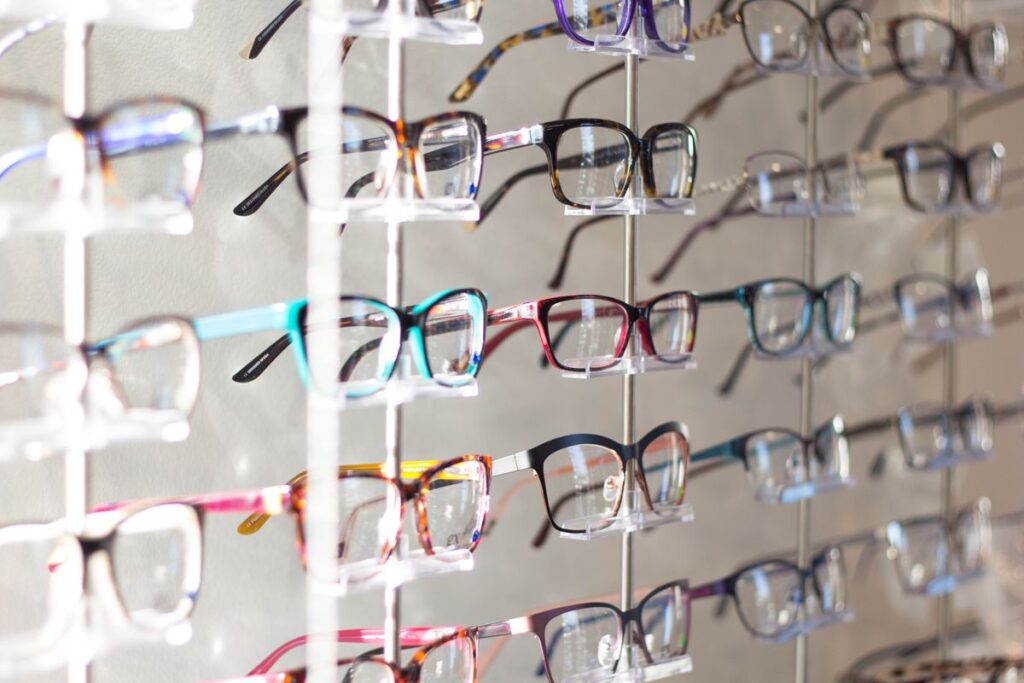The landscape of eye care is undergoing a significant transformation, driven by the integration of digital tools in optical stores. From cutting-edge vision testing technology to advanced eyewear fitting solutions, optical retail software, and telehealth services, the industry is embracing innovation to enhance patient care and streamline operations. This article delves into the various aspects of this digital revolution, highlighting the role of new technologies in revolutionizing both the patient experience and the business of optometry.
Key Takeaways
- Digital retinal imaging and automated refraction systems are modernizing vision testing, offering greater accuracy and efficiency.
- Augmented reality and sustainable materials are at the forefront of personalized eyewear fitting and fashion trends.
- Online optometry platforms and telehealth services are expanding access to eye care and improving patient engagement.
- Advanced prescription technology, including digital PD rulers and electronic prescription management, is enhancing precision in eyewear.
- Optical practice management is being optimized through software solutions, fostering growth and better client relationships.
The Digital Transformation of Vision Testing

Innovations in Retinal Imaging
One of the most significant advancements in vision testing technology is digital retinal imaging. This non-invasive diagnostic tool captures high-resolution images of the retina, optic nerve, and blood vessels at the back of the eye. These detailed images allow eye care professionals to evaluate the overall health of the eye, detect early signs of diseases such as glaucoma, macular degeneration, and diabetic retinopathy, and monitor the progression of existing conditions.
Digital retinal imaging offers several benefits over traditional eye examination methods, including increased patient comfort and reduced examination time. Urban Optiks Optometry embraces this technology to provide comprehensive and accurate eye evaluations in San Diego.
The integration of digital retinal imaging into routine eye examinations represents a leap forward in our ability to safeguard ocular health. It not only enhances the accuracy of diagnoses but also improves the patient experience by making the process quicker and more comfortable.
The following list outlines the key benefits of digital retinal imaging:
- Non-invasive procedure
- High-resolution imaging capabilities
- Early detection of ocular diseases
- Efficient monitoring of disease progression
- Improved patient comfort during examinations
- Quicker examination times compared to traditional methods
The Impact of Automated Refraction Systems
The advent of automated refraction systems has marked a significant milestone in the realm of vision testing. These systems, employing computerized technology, streamline the vision assessment process by accurately measuring refractive errors to determine the necessary corrective lenses. The precision of automated refraction not only expedites the examination but also enhances the reliability of the results, offering a more objective evaluation free from human error and subjective biases.
Automated refraction systems have been particularly transformative for practices like Urban Optiks Optometry, where they contribute to a more efficient workflow. Patients benefit from a quicker, more comfortable experience, and optometrists are able to focus on personalized care, leveraging the detailed data these systems provide.
The integration of automated refraction systems aligns with the broader trend of digitalization in optometry, which includes online platforms, telehealth services, and electronic health records (EHRs). These innovations collectively work to improve access, efficiency, and patient experiences across the board.
While the technology behind automated refraction is complex, the benefits are clear and measurable. Here’s a snapshot of the advantages:
- Reduced examination time
- Increased accuracy in prescriptions
- Minimized subjective input
- Enhanced patient throughput
- Improved patient satisfaction
Urban Optiks Optometry’s Approach to Modern Vision Testing
Urban Optiks Optometry stands at the forefront of the digital transformation in eye care, ensuring a thorough and precise diagnosis to develop targeted treatment plans. Their commitment to integrating the latest technology is evident in their use of digital retinal imaging, optical coherence tomography, and automated refraction systems. These tools not only enhance diagnostic accuracy but also contribute to a more personalized approach to eye care.
Embracing the future, Urban Optiks Optometry’s dedication to innovation is a testament to their pursuit of excellence in vision health.
By staying abreast of technological advancements, Urban Optiks Optometry offers their patients high-quality, precise, and efficient vision care. The integration of digital tools and teleophthalmology revolutionizes eye care with personalized treatment plans, advanced diagnostic services, and AI-driven solutions for optimal vision health. This approach not only positions them as a leader in the industry but also ensures that their patients are receiving the most modern care available.
Advancements in Eyewear Fitting and Sales

The Rise of Augmented Reality in Eyeglass Selection
The eyewear industry is undergoing a digital revolution with the integration of 3D, AR technologies, and sustainable practices. Virtual try-ons, online convenience, and personalized experiences are reshaping the retail landscape. Augmented Reality (AR) in eyewear is not just about adding a digital layer to our vision; it’s about enhancing our interaction with the world around us. Smart glasses, for instance, are designed to be lightweight and portable, making them suitable for daily use while providing valuable information overlaid on our natural environment.
The potential of AR in eyewear extends beyond mere fashion or convenience. It promises to transform various sectors by providing real-time data and insights, making it a tool with far-reaching implications.
Here are some notable examples of AR glasses that are setting trends in the market:
- X-Visions Prodigy AR Glasses: Technological sophistication meets style.
- ClearView Omni-Connect Specs: Seamless device integration for an advanced user experience.
- SpectraVision Enhanced Reality Frames: Cutting-edge technology for an improved AR experience.
As the technology matures, we may see a shift from bulky headsets to more discreet options like AR-enabled contact lenses, offering a seamless blend of the digital and physical worlds.
Sustainable and Smart Eyewear Trends
The eyewear industry is witnessing a significant shift towards sustainability and smart technology. Brands like Optigrid are at the forefront, offering innovative designs that not only cater to fashion but also emphasize environmental responsibility. These trends are reshaping how consumers and optical stores approach eyewear.
The integration of digital tools in eyewear is not just a fad; it’s a strategic move towards a more personalized and eco-friendly consumer experience.
With the rise of smart glasses, customers now have access to features such as AR enhancements and blue light protection, which cater to both style and health. The table below highlights some of the key features and benefits of sustainable and smart eyewear:
Urban Optiks Optometry is embracing these trends, revolutionizing optical care with a focus on digital eyeglasses fitting and sustainable practices. This approach not only benefits the environment but also enhances the customer experience, offering a glimpse into the future of optical retail.
Optical Retail Software: A Game Changer for Eyewear Sales
The integration of optical retail software has marked a significant shift in how eyewear is sold and managed. Optical retail software streamlines the entire sales process, from inventory management to customer interactions, making it a vital tool for modern opticians.
- Inventory Management: Keep track of stock levels and orders with real-time updates.
- Customer Relationship Management (CRM): Enhance customer service by managing client information and purchase history.
- Sales Analytics: Gain insights into sales trends and customer preferences.
- Marketing Tools: Execute targeted campaigns and promotions with ease.
The adoption of these digital tools not only simplifies operations but also provides a personalized shopping experience for customers. By leveraging data analytics, optical stores can tailor their offerings and marketing strategies to meet the unique needs of their clientele.
The landscape of eyewear sales is evolving, and optical retail software is at the forefront of this transformation. As highlighted by Optigrid, these solutions cater to diverse shop models and are instrumental in driving growth and community engagement. The future of eyewear fashion and health is closely tied to the advancements in retail technology, promising an exciting era for optometry.
The Evolution of Online Optometry

Telehealth: Bringing Eye Care to the Digital Age
The advent of telehealth has been a game-changer in the field of optometry, democratizing access to eye care services for patients regardless of their location. Through teleophthalmology, individuals in remote or underserved areas can now receive expert consultation and diagnosis without the need to travel long distances.
The integration of telecommunication technology into eye care enables professionals to conduct remote consultations, diagnose conditions, and monitor treatment progress with the aid of digital imaging and secure data transmission.
The COVID-19 pandemic served as a catalyst for the widespread adoption of telemedicine, including in the realm of eye care. Ophthalmology practices have embraced telemedicine capabilities within their Electronic Medical Records (EMR) systems, facilitating virtual consultations and remote patient monitoring. This shift not only enhances patient convenience but also ensures continuity of care during challenging times.
Here are some key benefits of teleophthalmology:
- Expanded access to specialized eye care
- Reduced need for in-person visits
- Enhanced collaboration among eye care professionals
- Proactive management of chronic conditions like glaucoma and diabetic retinopathy
Urban Optiks Optometry is at the forefront of this transformation, integrating advanced teleophthalmology solutions to provide high-quality eye care that is both efficient and patient-centric.
Electronic Health Records (EHRs) and Patient Data Management
The adoption of Electronic Health Records (EHRs) in optometry practices has marked a significant shift towards more efficient and secure patient data management. Interoperability and integration capabilities are at the forefront, ensuring that EHR systems can communicate with hospital EMRs, practice management software, and other healthcare systems. This seamless exchange of data supports coordinated care and enhances the patient experience.
Enhanced security and privacy measures have become paramount with the digitization of healthcare data. Developers are now focusing on robust encryption protocols, multi-factor authentication, and data anonymization techniques to protect patient information and ensure compliance with regulations like HIPAA.
The streamlined patient registration and check-in process facilitated by EMR software significantly reduces paperwork and improves the accuracy of patient information at the point of care.
Ophthalmology EMR software not only centralizes medical records and appointment scheduling but also integrates with diagnostic devices for improved clinical decision-making. The table below summarizes the key benefits of EHRs in optometry:
The Role of Digital Tools in Enhancing Patient Experience
The integration of digital tools in optometry has significantly improved the patient experience. Virtual optometrist tools are at the forefront, offering AI diagnostics and personalized treatment plans. These advancements have made eye care more accessible and convenient, particularly through telemedicine services.
Telemedicine consultations have become a staple in modern eye care, allowing patients to receive professional advice without the need to travel. Secure video conferencing and virtual examination tools enable real-time review of patient images and test results, streamlining the treatment process.
The use of digital tools in optometry not only enhances clinical efficiency but also empowers patients. Through educational resources and interactive tools provided by EMR software, patients are more engaged and informed about their eye health.
Here is a list of key features that digital tools offer to enhance patient experience:
- Secure video conferencing for remote consultations
- Real-time access to patient images and test results
- Educational materials and treatment guidelines through patient portals
- Mobile applications for scheduling and communication
- Enhanced security and privacy measures to protect patient data
These features collectively contribute to a more personalized and patient-centric approach to eye care.
Prescription Technology and Management

Digital PD Ruler: Precision and Comfort
The advent of digital PD rulers has marked a significant leap forward in the realm of eye care. These innovative tools offer a level of precision in measuring pupillary distance that surpasses traditional methods. The benefits are manifold; not only do they enhance the accuracy of prescriptions, but they also contribute to a more comfortable and efficient patient experience.
- Enhanced Accuracy: Digital PD rulers reduce the margin of error, ensuring that eyewear fits perfectly.
- Improved Patient Experience: The non-intrusive nature of digital measurements provides a stress-free visit.
- Efficiency in Practice: Streamlined processes allow for quicker appointments and better resource management.
The integration of digital PD rulers into optical practices is a testament to the industry’s commitment to technological advancement and patient-centered care.
While the adoption of digital PD rulers is gaining momentum, it varies significantly by region and practice size. There is a clear potential for widespread integration, especially with the advent of AI enhancements that could further revolutionize this aspect of eye care. The table below illustrates the adoption rates across different regions:
The future of pupillary distance measurement looks bright, with digital PD rulers at the forefront of this transformation.
Electronic Prescription Management Systems
Electronic Prescription Management Systems (EPMS) are revolutionizing the way ophthalmologists prescribe medications. By ensuring compatibility with pharmacy systems, EPMS facilitate the electronic prescribing of ophthalmic drugs and post-operative medications, streamlining the process for both providers and patients. Customizable templates and documentation tools within these systems allow for personalized care plans and efficient medication management.
- Treatment planning and medication management are enhanced by access to evidence-based guidelines and medication databases.
- Automated reminders and patient history access improve patient engagement and satisfaction.
- Integration with diagnostic devices and telemedicine consultations are facilitated, providing a comprehensive approach to eye care.
With the adoption of EPMS, ophthalmology practices are experiencing a significant improvement in workflow optimization and patient care delivery. The integration of these systems with telehealth services further improves diagnostic accuracy and accessibility, ensuring comprehensive eye care services are more readily available to patients.
Custom Lens Solutions and Smart Integration
The landscape of custom lens solutions is rapidly evolving, with digital tools playing a pivotal role in their development. Advanced mapping and imaging technologies have enabled the creation of lenses that are not just corrective but also tailored to the individual’s unique visual needs. This personalization is achieved through computer-aided design and manufacturing, including the use of 3D printing techniques for a precise fit and enhanced visual performance.
In the realm of smart integration, innovations in materials and integrated technology are pushing the boundaries of what’s possible. Smart contact lenses, for example, can now monitor eye health in real-time, offering a new level of convenience and proactive care. The ability to rapidly prototype and iterate designs means that new solutions can be brought to market more quickly, meeting the demands of consumers who seek both functionality and comfort.
The synergy between custom lens design and smart technology is not just reshaping the industry; it’s providing patients with a level of customization and control over their vision care that was once unimaginable.
As the industry continues to innovate, companies like Lenskart are at the forefront, revolutionizing eyewear shopping with virtual try-ons and personalized recommendations. Their focus on sustainability and embracing omnichannel strategies ensures a seamless customer experience that aligns with modern consumer expectations.
Optical Practice Management and Growth

Software Solutions for Optical Shop Efficiency
In the realm of optometry, software solutions are pivotal for enhancing operational efficiency in optical shops. These digital tools are designed to simplify administrative tasks, manage inventory, and facilitate patient appointments, ultimately leading to a more streamlined practice.
- Appointment scheduling: Automated systems allow for easy booking and rescheduling, reducing no-shows and optimizing the optometrist’s time.
- Inventory management: Real-time tracking of eyewear and contact lenses ensures that stock levels are maintained efficiently.
- Patient management: From initial registration to follow-up reminders, software solutions keep patient information organized and accessible.
- Reporting and analytics: Insightful data analysis helps in making informed decisions about the practice’s growth and service quality.
Embracing these technologies not only improves the day-to-day operations but also enhances the overall patient experience. By integrating comprehensive software systems, optical shops can focus more on patient care and less on the paperwork.
Digital optometry tools enhance patient experience, improve diagnostic accuracy, and streamline workflow processes in eye care practices, transforming healthcare delivery.
Integrating Digital Tools for Client Engagement
The integration of digital tools into optical practices has revolutionized client engagement, offering a more personalized and efficient service. Software solutions now enable seamless interactions between patients and eye care providers. For instance, the integration with diagnostic devices such as OCT machines and fundus cameras allows for immediate capture and storage of diagnostic images within patient records, streamlining the consultation process.
The use of telemedicine consultations through secure video conferencing and virtual examination tools has opened new avenues for patient care, making it possible for clinicians to offer real-time guidance and treatment plans remotely.
Patient engagement is further enhanced by features like:
- Personalized patient profiles
- Clinical documentation
- Efficient appointment scheduling
These advancements ensure that every aspect of the patient’s journey is managed with precision and care, from initial contact to treatment planning and follow-up. The development and integration of these systems require careful planning to ensure interoperability with existing healthcare systems, which is crucial for a holistic approach to patient management.
Navigating the Future of Optometry with Technology
As optometry ventures further into the digital era, practices must adapt to stay at the forefront of patient care and business growth. The integration of advanced technologies is not just a trend, but a necessity for future-proofing optical practices.
Optical stores are increasingly leveraging digital tools to enhance every aspect of their operations, from patient engagement to inventory management. Here’s a glimpse into the key areas of focus:
- Patient Engagement: Utilizing digital platforms for appointment scheduling, reminders, and follow-ups.
- Inventory Management: Implementing RFID and barcode systems for accurate tracking of eyewear.
- Data Analytics: Employing analytics to understand customer preferences and buying patterns.
- Marketing: Crafting personalized marketing campaigns based on customer data.
Embracing these digital advancements allows optometrists to provide a more personalized and efficient service, ensuring that patients receive the best possible care while also streamlining practice operations.
The future of optometry will be characterized by a continuous evolution of technology. Practices that can adapt and integrate these digital tools effectively will not only survive but thrive in the competitive landscape of eye care.
In the ever-evolving world of eye care, effective optical practice management is the cornerstone of growth and success. Discover how our innovative strategies at OPTIGRID can transform your practice. Stay ahead of the curve by signing in to access a wealth of resources tailored to your business needs. Don’t let your practice fall behind—visit our website now and take the first step towards a brighter future.
Conclusion
The integration of digital tools in optical stores is not just a trend; it’s a transformative movement that is reshaping the landscape of eye care. From the precision of digital PD rulers to the convenience of online optometry platforms, these advancements are enhancing the accuracy of prescriptions, the efficiency of eye exams, and the personalization of eyewear fitting. Urban Optiks Optometry exemplifies the potential of these technologies in providing superior patient care. As we look to the future, it is clear that embracing these digital innovations is key to offering an elevated experience in vision care, ensuring that both optometrists and patients are equipped with the best tools for eye health and fashion.
Frequently Asked Questions
How is digital retinal imaging transforming eye care?
Digital retinal imaging allows for high-resolution scans of the retina, aiding in early detection and treatment of eye diseases. It enhances patient comfort and reduces examination time.
What are the benefits of automated refraction systems?
Automated refraction systems provide quick and accurate measurements of a patient’s prescription, improving the efficiency of eye exams and ensuring precise vision correction.
How do augmented reality (AR) technologies affect eyeglass selection?
AR technologies enable customers to virtually try on eyeglasses, allowing for a more interactive and personalized selection process without the need for physical fitting.
What role do electronic health records (EHRs) play in optometry?
EHRs streamline patient data management, improve the accuracy of records, and facilitate better communication between healthcare providers, enhancing overall patient care.
How does the digital PD ruler improve prescription accuracy?
The digital PD (Pupillary Distance) ruler uses AI-driven technology to measure the distance between pupils with precision, ensuring that eyeglass lenses are correctly aligned for optimal vision.
What advancements in optical practice management software are shaping the industry?
Optical practice management software is revolutionizing the industry by automating administrative tasks, improving client engagement through digital tools, and providing analytics for business growth.

I am a seasoned software engineer with over two decades of experience and a deep-rooted background in the optical industry, thanks to a family business. Driven by a passion for developing impactful software solutions, I pride myself on being a dedicated problem solver who strives to transform challenges into opportunities for innovation.
